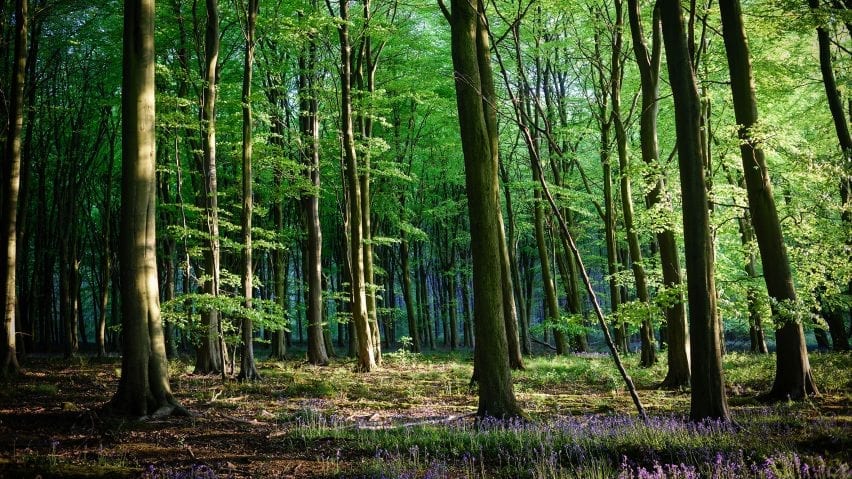
"Carbon can be an ally in a regenerative future"
By understanding the carbon cycle, designers can work hand in hand with nature to develop sustainable new materials, writes Sebastian Cox.
For trees, anthropogenic climate change is a mixed blessing. If they were capable of rational thought, they would surely be enjoying the extra CO2 in the atmosphere, which increases their mass.
Wood is carbohydrate synthesised from CO2; plants thrive in carbon-rich atmospheres unlike mammals, which perform better with greater concentrations of oxygen in every lungful.
Some trees may be finding temperate climates heating up beyond their preferred conditions, which would of course be very bad news for them. But running with the idea of tree sentience, our ent-like friends would be wise enough to have appreciated that man's discovery of coal saved millions of acres of temperate forest since our prime energy source switched from land-hungry wood to buried fossil energy.
What if we could take a tree's perspective and see the extra CO2 as a resource we can work with?
Of course, tropical forests and wildlands suffer today from the developed world’s insatiable appetite. It’s a mixed and messy picture, as all human endeavours seem to be, but viewing it from the point of view of trees might help us understand it better.
Global heating is a threat to life on earth, but pinning all blame on atmospheric carbon dioxide is a narrow view of our problems. We do need to cease burning fuel that should be left in the ground and we should redress the imbalance we have made with carbon in our skies and seas, but carbon itself isn’t the devil. Rather, it is a substance that our hunger for progress put in the wrong place.
We need to switch to renewable energy that isn’t land-hungry, too. Technology has the answers to our energy needs but the solutions for reducing our carbon imbalance are to be found in studying and working with nature’s cycles and systems.
A good way to do this is to try to view our problems from the perspective of organisms or ecosystems: what if we could take a tree's perspective and see the extra CO2 as a resource we can work with?
Carbon from photosynthesis, not from fossils, should as much as possible constitute the fabric of the things we use and buy.
Carbon is, after all, essential for life. We are made of it, and it’s worth remembering that without the miracle of the greenhouse effect, our planet would be around minus 18 degrees Celsius. We’ve knocked a natural cycle out of balance, but all parts of that cycle are still important to the miracle that is life on earth.
I believe that carbon can be an ally in a regenerative future if we view it in two ways. Firstly, carbon from photosynthesis, not from fossils, should as much as possible constitute the fabric of the things we use and buy. If we restructure our built and material environment using photosynthesised carbohydrates like wood while re-growing the plants we use, we can regeneratively intervene in the carbon cycle.
There is an important definition between deforestation and forestry: as long as the land remains woodland or forest, harvesting the trees is not the same as deforestation. But converting the cleared land to agriculture is.
Of course, this switch in material culture would have been coupled with a move away from emissions-intense materials like concrete and steel to achieve decarbonisation. The mass-timber buildings being built today show this is possible.
In natural environments, carbon is released when wood rots or burns in forest fires. This recycles the carbon, making it available for other vegetation to absorb.
Our buildings are perfect silos for carbon in the form of mass timber.
By the happy accident of wanting to inhabit dry, warm spaces, humans have created interior environments where dried plant matter, like wood from trees or linen from flax, can be preserved indoors without rotting, thereby retaining its carbon for hundreds of years.
Meanwhile, our buildings, which we’re going to need many more of in this century, are perfect silos for carbon in the form of mass timber. As long as the forests or crops regrow, carbon is absorbed with each new cycle while the previous crop’s carbon is stored in the object.
This should form a sound base for a regenerative existence, but it won’t solve the problem alone. The vast volume of buildings we’d have to build to balance the CO2 books through sequestration makes the role of architecture and manufacture just one small but very important part of the solution.
It’s important to understand that 95 per cent of the earth’s surface carbon is dissolved in the ocean. As we’ve emitted carbon that was in the ground, the ocean has soaked it up in equilibrium with the sky. As we go beyond net-zero and start to remove carbon from the atmosphere, the ocean will continue to balance, releasing that excess carbon back to the sky.
Excess carbon’s impact goes beyond just the heating of our earth.
Because of this, even with the greatest carbon-negative intentions, it would take several hundred years to return atmospheric carbon to pre-industrial levels. We must still endeavour to rebalance the carbon cycle since a natural cycle that goes off-kilter causes damage elsewhere.
Excess carbon’s impact goes beyond just the heating of our earth. It also acidifies our oceans. So using carbon as a resource at every opportunity is the brief we designers must set ourselves.
This centuries-long journey to correcting the carbon cycle feels like a bleak picture but there is hope here, yet again in the form of plants. This brings me to my second view of carbon as an ally: it is the foundation of a hydrology system that cools the planet.
It is in fact water vapour, not carbon dioxide, that is the most abundant greenhouse gas that exerts the greatest pull on global temperatures. The water cycle provides 95 per cent of the effect on the heat dynamics of our planet, whereas carbon dioxide’s impact is four per cent. To solve the existential threat of global heating, we should be also looking to the water cycle to cool our earth.
So how could we possibly control atmospheric water movement? It can be done via a process called transpiration, which is the movement of water through vegetation. When water travels through a plant, it uses energy from the sun, creating a cooling effect as it transpires, in exactly the same way that our sweat cools us.
It takes about 590 calories of energy to transpire a gram of water. When we’re talking litres of water, that’s a lot of calories. You will have noticed how woodland is a cool retreat on a hot day. The more water we can hold on land, the more vegetation can colonise and transpire, and the cooler our planet becomes.
You may also have noticed how moist a healthy woodland soil can feel, even when periods of drought have parched adjacent fields. For every one gram of extra carbon in soils, eight grams of extra water can be held there too because of the complex hygroscopic structure of soil carbon.
The double win of locking both carbon and water into soil and plants should be at the forefront of every designer’s mind.
The more carbon we put in our soils through growing plants in healthy soil, the more water they can hold, leading to more transpiration and eventually more rain. Interestingly, it’s the presence of trees that causes rain in rainforests, not the other way round. The reverse scenario can be true too: remove the forest, and you remove the rain, beginning a journey to becoming desert.
To create more climate-cooling transpiration we should, of course, increase vegetation cover at every opportunity and do so with methods that don’t degrade soils. The double win of locking both carbon and water into soil and plants should be at the forefront of every designer’s mind.
And we should develop a nuanced understanding of these core issues. Monoculture maize sown into ploughed earth and reared with chemicals is not going to help hold water or carbon on land. Native woodland, rewilded land and permanent grassland will.
Walter Jehne, a soil microbiologist and climate scientist who is a leading voice in regenerative agriculture, claims that we’d need to return four per cent of the earth’s degraded land to healthy forest to restore temperatures quickly and safely through the water cycle. Given that we’ve degraded 50 per cent of the earth’s land surface, this seems possible.
If we understand that the hydrological system gives us our largest potential agency over the temperature of our planet, then the way we use our land is our most important consideration for tackling our climate emergency. We need to absorb carbon and cease the unnatural release of it, but we also need to vegetate and regenerate to cycle water and cool.
As designers, we have even more agency than the wider population as we influence and shape how our built and material culture operates. We should better understand the habitats our materials come from and shape our material world around solutions to our existential problems.
The design community should be leading the material world into an intense period of re-greening and cooling our planet, and it should start by finding ways to make the excess carbon we have in our skies a resource to be used to regenerate our earth.

Carbon revolution
This article is part of Dezeen's carbon revolution series, which explores how this miracle material could be removed from the atmosphere and put to use on earth. Read all the content at: www.dezeen.com/carbon.
The sky photograph used in the carbon revolution graphic is by Taylor van Riper via Unsplash.